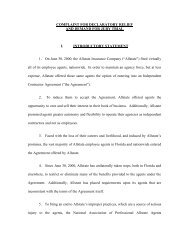Exclusivefocus Spring 2013 - National Association of Professional ...
Exclusivefocus Spring 2013 - National Association of Professional ...
Exclusivefocus Spring 2013 - National Association of Professional ...
You also want an ePaper? Increase the reach of your titles
YUMPU automatically turns print PDFs into web optimized ePapers that Google loves.
sales and marketing<br />
Reinventing an Unloved<br />
Marketing Strategy<br />
By Scott Brodbeck<br />
Have you ever heard that direct<br />
mail is one <strong>of</strong> the worst ways to<br />
spend your marketing dollars<br />
With an average response rate between<br />
1 and 2 percent, it would be difficult to<br />
argue that the rate <strong>of</strong> return justifies pursuing<br />
this form <strong>of</strong> marketing. It would<br />
be even more difficult to advocate using<br />
direct mail as your primary method <strong>of</strong><br />
marketing, but that’s exactly what this<br />
article will attempt to do.<br />
Before dismissing this idea and moving<br />
on to the next article, let me clarify<br />
a few things. I agree that direct mail in<br />
general isn’t a very good way to market<br />
your business, but the reason response<br />
rates are so low is because direct mail<br />
usually takes a carpet bomb approach<br />
in order to reach as many prospects as<br />
possible. As a result, the vast majority<br />
<strong>of</strong> people receiving a solicitation from<br />
you aren’t aren’t likely to be interested in<br />
whatever it is you’re selling, and depending<br />
on what your mail piece looks like,<br />
they may not even open it.<br />
Therefore, instead <strong>of</strong> using the saturation<br />
method, where everyone in a particular<br />
geographic area receives your direct<br />
mail piece, it makes more sense – and<br />
costs less money – to gear your marketing<br />
efforts toward prospects who are most<br />
likely to be interested in what you’re selling.<br />
This is referred to as targeted direct<br />
mail. Ideally, you want to find a group <strong>of</strong><br />
people who either are looking for what<br />
you have to <strong>of</strong>fer or who are open to<br />
hearing what you have to say.<br />
Let’s think about that from the perspective<br />
<strong>of</strong> a landlord who owns multiple rental<br />
properties. When all the properties are<br />
rented to stable tenants who pay their rent<br />
on time and rarely call with maintenace<br />
issues, the landlord is on top <strong>of</strong> the world<br />
and any issues associated with the properties<br />
are not top <strong>of</strong> mind. But when a tenant<br />
moves out, the landord’s relaxed mindset<br />
suddenly shifts to “dealing with a vacant<br />
property.” This means making repairs,<br />
slapping on a fresh coat <strong>of</strong> paint, advertising<br />
the property and showing it. Every day<br />
without a tenant is a day without rental<br />
income, but that’s not all. Continuing expenses,<br />
such as taxes, mortgage payments,<br />
insurance and utilities must be paid, as do<br />
costs to make the property rentable again.<br />
Could there be a better time to approach<br />
this individual about saving money on their<br />
property insurance I think not.<br />
I’ve always been a fan <strong>of</strong> the Landlords<br />
Package Policy (LPP) – not because the<br />
premiums are the best in town, but because<br />
the multi-policy discount for having<br />
home and auto is pretty substantial in<br />
many states. Typically, local newspapers<br />
run ads for house rentals, which almost<br />
always include the landlord’s telephone<br />
number. What if you cross-referenced<br />
the phone numbers to find out the mailing<br />
addresses <strong>of</strong> each landlord Presto,<br />
now have a mailing list <strong>of</strong> landlords who<br />
may be at their most vulnerable – when<br />
their expenses are high and who are in<br />
the throes <strong>of</strong> finding tenants. It is beyond<br />
the scope <strong>of</strong> this article to go through the<br />
logistics <strong>of</strong> transforming phone numbers<br />
to addresses; but it can be done if you’re<br />
tech savvy and if not, you may want to<br />
consult a tech consultant.<br />
Now let’s move on to targeted homeowner<br />
opportunities. Many people buy<br />
their property insurance from their car<br />
insurance agent and never give it a second<br />
thought. Sending a letter out <strong>of</strong> the<br />
blue to someone about their homeowners<br />
insurance will likely result in the normal<br />
1 to 2 percent response rate. But if you<br />
specifically target homeowners who are<br />
coming up on the anniversary <strong>of</strong> their<br />
purchase date, and if you have a quote in<br />
their hands prior to the receipt <strong>of</strong> their<br />
dec sheet, you will significantly increase<br />
the likelihood <strong>of</strong> a response. Keep in<br />
mind that many policies are billed to the<br />
mortgage company. This creates a couple<br />
<strong>of</strong> obstacles: the first is that you must time<br />
your mailing so it arrives before the motgagee<br />
pays the premium, and the second<br />
is to get your prospects to pay attention to<br />
what you’ve sent them.<br />
When mortgage companies pay the<br />
premium, policyholders don’t tend to<br />
notice rate increases because they aren’t<br />
the one writing the check. When they<br />
receive a notice that says, “Do not pay,<br />
mortgagee has been billed,” they typically<br />
file it away, <strong>of</strong>tentimes without ever<br />
looking at the premium. Your job as a direct<br />
mail marketer is to give them a reason<br />
to shop. Send a mailing that makes<br />
them question their existing coverage<br />
or policy premium. For example, what<br />
if your mail piece asked, “Will you see<br />
a $20 to $50 increase in your monthly<br />
mortgage payments because your homeowner<br />
insurance rates have gone up”<br />
The idea is to pique their interest with<br />
an attention-grabbing headline.<br />
The new House & Home product<br />
has rates that have disappointed many<br />
agents, and true to form, the company<br />
has continued its tradition <strong>of</strong> putting the<br />
majority <strong>of</strong> the insurance buying public<br />
into non-competive IS scores, leaving<br />
only a tiny segment <strong>of</strong> prospects with<br />
a competitive rate. However, there is a<br />
better than average chance that those<br />
in this segment live in close proximity<br />
to one another – in neighborhoods<br />
with higher than average credit. Your<br />
34 — <strong>Exclusivefocus</strong> <strong>Spring</strong> <strong>2013</strong>
















